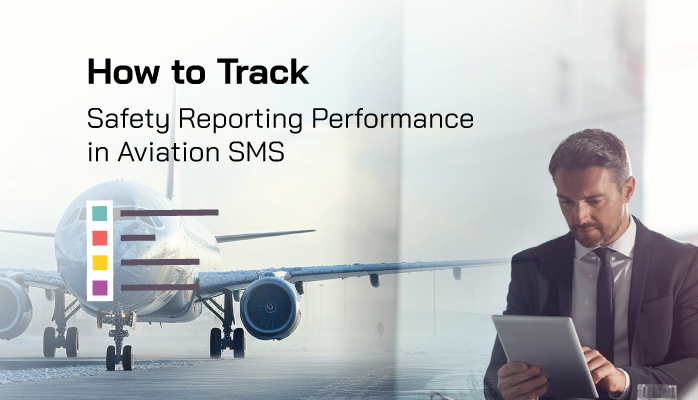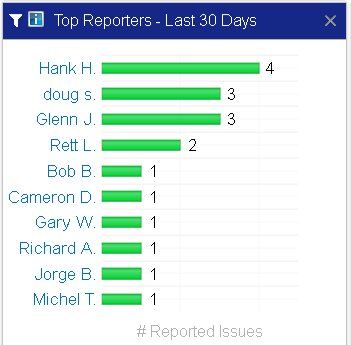Global Problem of Safety Reporting Performance

Employee involvement in aviation safety management systems (SMS) is a major struggle for countless organizations.
The unfortunate fact – and this is something we hear regularly – is that finding good safety incentives and accountability for employees' safety performance in aviation SMS implementations is tough.
One of the primary problems here is the “so what” factor.
Employees who do not participate feel like there aren't any consequences (positive or negative) for their SMS involvement levels. I’m not advocating punitive measures, but only to say that encouraging employees to participate “for the good of safety” is a poor excuse to motivate a struggling hazard reporting culture.
Related Aviation Safety Reporting Articles
- Understanding Role of Hazard Identification Training and Safety Reporting Forms in Aviation SMS
- How Confidential Aviation Safety Reporting Systems Offer Assurance to Employees
- 5 Simple Tips to Improve Aviation Safety Reporting Cultures
Aviation SMS Incentives Need to Be Personal
Humans, in general, need stakes for an activity or concept to become personally relevant. It is for this reason that monitoring the safety performance of individual employees is such a powerful tool for managers.
When employees know that their safety performance is being monitored and that their activity will directly impact the performance of their position in the company, chances are they will make a much better effort at being involved in SMS activities.
Moreover, when management monitors individuals’ safety performance, it sends the message that safety performance is a necessary and important part of overall job performance. For these reasons, the aviation safety chart for "Top Reporters in the Last 30 Days" is an extremely useful visual display for a baseline monitor of who is participating in the program.
Safety promotion is also affected by showing employees examples of other employees actively engaged in hazard identification and safety reporting activities. Safety promotion is achieved by:
- Showing employees which employees are participating the most; and
- Providing recognition to active employees for their SMS participation.
What This Chart Reveals About SMS Safety Reporting Activity

The usefulness of this SMS performance monitoring chart is that it shows the top 10 reporters in the last 30 days. Directly, this chart shows right away who the top performers are for identifying hazards and taking the time to report these concerns to management. Indirectly, it also reveals who is NOT ever active enough to appear in the top 10.
Consider a real case scenario, where an aviation safety manager keeps regular tabs on this chart and monitors the top hazard reporting performers. Over time it will become apparent which employees are frequently in the top 10 and which employees are not.
Secondly, if there is a considerable disparity of reported safety issues between the safety reporting metrics of a top few performers compared to the rest of the employees, it should raise several questions like
- Why are only a few employees accounting for most of the reported safety issues?
- Which limiting factors hold back other employees from reporting as well?
- Are other employees piggybacking on the safety performance of the top few performers?
- Do active reporters belong to a particular area of operations with more effective safety promotion campaigns?
Related Aviation Safety Reporting Articles
- How to Monitor Aviation Safety Reporting Culture Using Safety Charts
- How to Make Safety Reporting Forms for Aviation SMS - With Resources
- How to Develop Healthy Safety Reporting Cultures in Aviation SMS
How Is Employee Safety Reporting Performance Monitored?
For sustainability and real-time performance monitoring, the ability to monitor employee safety performance requires an aviation safety reporting database to track:
- Who is reporting safety issues; and
- When they reported issues.
The safety reporting database may be a stand-alone point solution that is integrated with your SMS performance monitoring dashboards. Point solutions are designed to address a single organizational pain point, such as:
- Safety reporting system;
- Risk management system;
- SMS performance monitoring system;
- Auditing system;
- Document management system;
- Safety promotion system; or
- SMS Training system.
There are more sophisticated SMS databases that integrate multiple business processes into a centralized database. SMS Pro is an example of an integrated SMS data management system. SMS Pro is a system of integrated systems designed to address all SMS documentation requirements. These integrated databases are easier to manage than a group of cobbled-together point solutions.
Tracking Safety Reporting Metrics in SMS Database
Instead of managing SMS data in six to ten separate point solutions, a centralized SMS database makes more sense for organizations that wish to reduce the complexity of their SMS data management strategy while also improving organizational safety performance. Since all required SMS systems are managed under one platform, it becomes cheaper and more efficient to use one powerful SMS database that has been designed for the specific purpose of managing SMS documentation requirements.
Regardless of your database, you will need a list of reports from the past thirty days, as well as the names of employees submitting these reports. There will be reports that won't be suitable for inclusion in this data set, such as
- Anonymous safety reports;
- Confidential safety reports; and
- Safety reports management considers "sensitive."
This safety chart filters safety issues reported within the past thirty days, then lists the total times each employee reported a safety issue and sorts them from greatest to least.
With professional aviation SMS database software this safety chart will be automatically produced in real-time using the latest safety reporting statistics. However, even a simple storage program like Excel can, with a bit of filter magic, produce the requisite data – though it wouldn’t be in chart form and it won't be in real-time.
Related Aviation Safety Reporting Articles
- What Is Missing Most in Aviation Safety Reporting Systems?
- 4 Hard Truths About Hazard and Safety Reporting in Aviation SMS
- How to Get Employees Participating in Safety Reporting - Aviation SMS
How the Safety Reporting Chart Addresses SMS Requirements

While the "Top Reporters – Last 30 Days" safety chart does not directly address aviation SMS compliance requirements – after all, there are not any compliance requirements that says all employees have to participate – it should be a good indicator of the overall performance of the SMS implementation.
Full aviation SMS implementation cannot happen without employee support and involvement, and this chart should give safety managers and the accountable executive a head start on seeing progress in the SMS' hazard reporting culture.
For every SMS implementation, the accountable executive is responsible for ensuring the SMS is properly implemented and performed in all areas of the organization. One of the best indicators of performing SMS is "system monitoring activity" in operational safety assurance processes. Safety reporting activity directly demonstrates SMS performance.
Key SMS performance measurements include safety reporting metrics. Each month, you should expect 10 reports for every 100 employees.
How are your safety reporting metrics?
85% of you will not have 10 reports for every 100 employees who enter your SMS safety reporting system. This may be good news if you want to say that "our reporting numbers are not the worst in the industry." However, if your safety reporting numbers are substandard, your SMS will never return the benefits promised by regulatory authorities.
The accountable executive must regularly review organizational safety performance to fulfill his responsibility to the SMS. This chart supplements other SMS performance monitoring charts. While not providing all the information required for adequately monitoring SMS performance, this chart helps accountable executives fulfill their responsibility to monitor the SMS and direct actions necessary to address substandard safety performance in a timely manner.
Who Cares About SMS' Safety Reporting Charts?
This is one of those safety charts that concerns everyone. It’s useful for:
- Safety managers and department heads to get a beat on who is practicing situational awareness as evidenced by their hazard identification activity;
- Accountable executives and safety professionals can easily glimpse a snapshot of the SMS' safety reporting culture;
- Safety managers who would like to reward individual employees for their safety performance;
- Front-line employees who are motivated by the reward of their name being posted in a visible location; and
- Front-line employees who should be aware that their safety performance (or lack thereof) is being monitored.
This chart really is a safety promotion chart.
How do I get my name on this chart so my manager can see that:
- I'm motivated;
- I'm paying attention to my surroundings;
- I'm a team player;
- I want a more active role in this company.
This chart provides employees an opportunity to "shine" in management's eyes. For toxic safety cultures, employees may not be motivated to have their names posted on an electronic safety performance dashboard. However, for healthy safety cultures, this chart serves as an incentive for employees to become more observant of potential safety concerns and to report safety concerns as quickly as possible.
Related Aviation Safety Promotion Articles
- 4 Pillars | What Is Safety Promotion Component (the "Overlooked" Pillar)
- Safety Chart: Stay on Top of Aviation Safety Promotion With SMS Newsletters
- 10 Best Ways to Promote Safety in Your Aviation SMS [With Free Checklist]
Final Thought: Similar Charts in an SMS Dashboard
Another similar performance monitoring chart that works well in conjunction with the current chart is the "Top Reporters – All Time." The "Top Reporters – All Time" chart shows the top 10 reporters and their total number of reported safety issues while at your organization.
An SMS performance monitoring dashboard should have multiple charts that allow managers to view safety performance across the entire breadth of the SMS implementation. For example, SMS Pro has approximately 45 dashboard charts. One should not assume that every chart is meant to add decision-making value to all viewers. Some charts are designed for quality assurance teams, operational department heads, or the training department.
Safety reporting charts are useful to a wider range of audiences due to the myriad inferences one can draw from safety reporting metrics, including:
- health of safety reporting culture;
- user-friendliness of safety reporting processes;
- employee's belief in the non-punitive reporting policy;
- management's relationship to line-level employees; or
- effectiveness of safety promotion campaigns.
SMS dashboard charts provide a visual display of SMS activity. It will be up to the safety team and the accountable executive to determine the appropriate actions necessary whenever interpreting these charts. The main points to consider are:
- Do you have the ability to provide real-time charts like this?
- Does management really care about safety reporting metrics?
- Do you have the tools necessary to improve a safety reporting culture?
- Would you like some help with safety reporting?
Perhaps the easiest way to increase hazard identification and safety reporting performance is to reduce friction from your safety reporting processes.
Watch how quickly an employee should be able to submit an issue using a Web-based hazard reporting solution.
Last updated January 2025.








